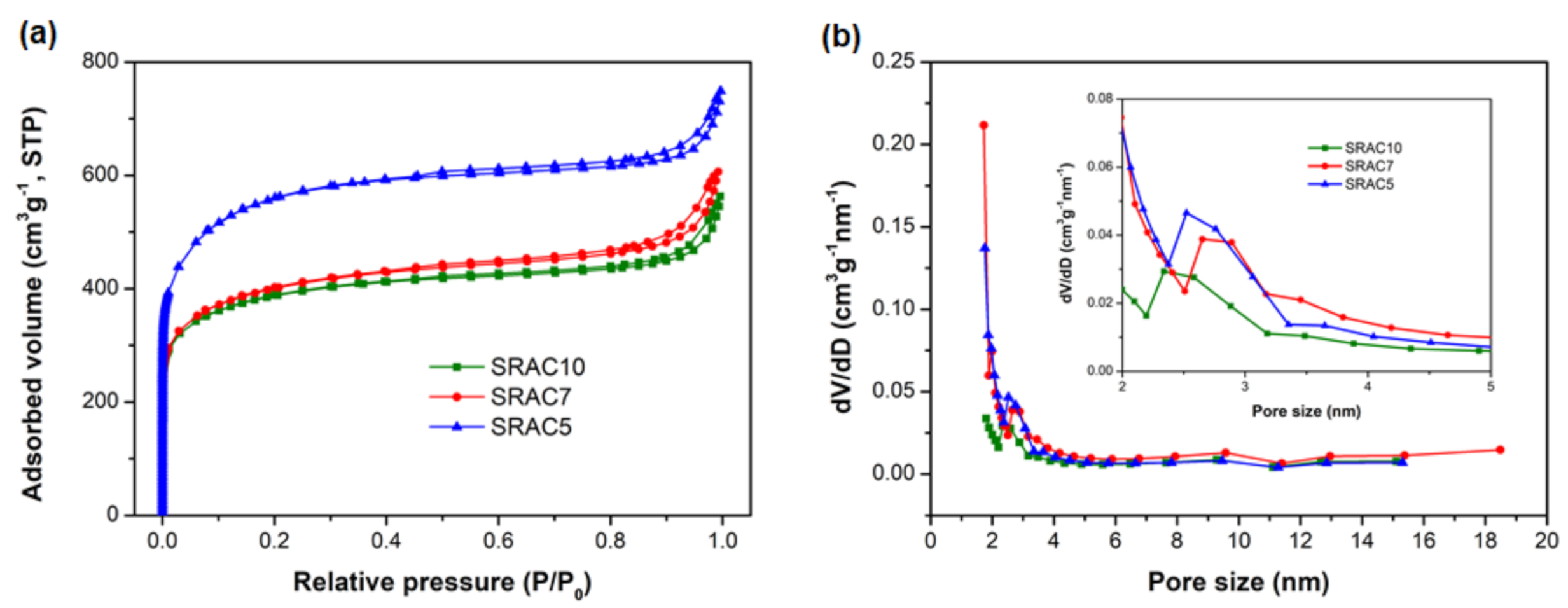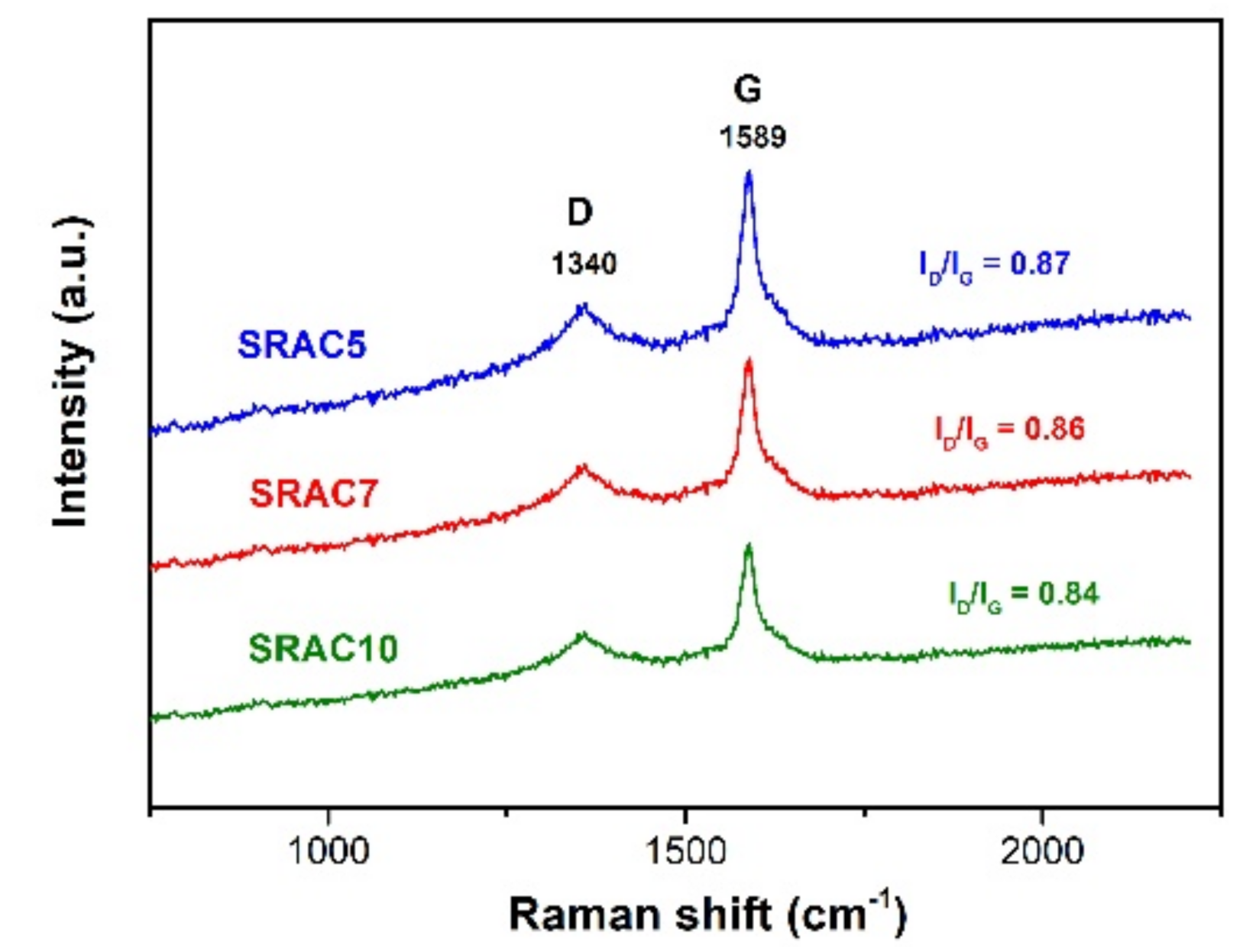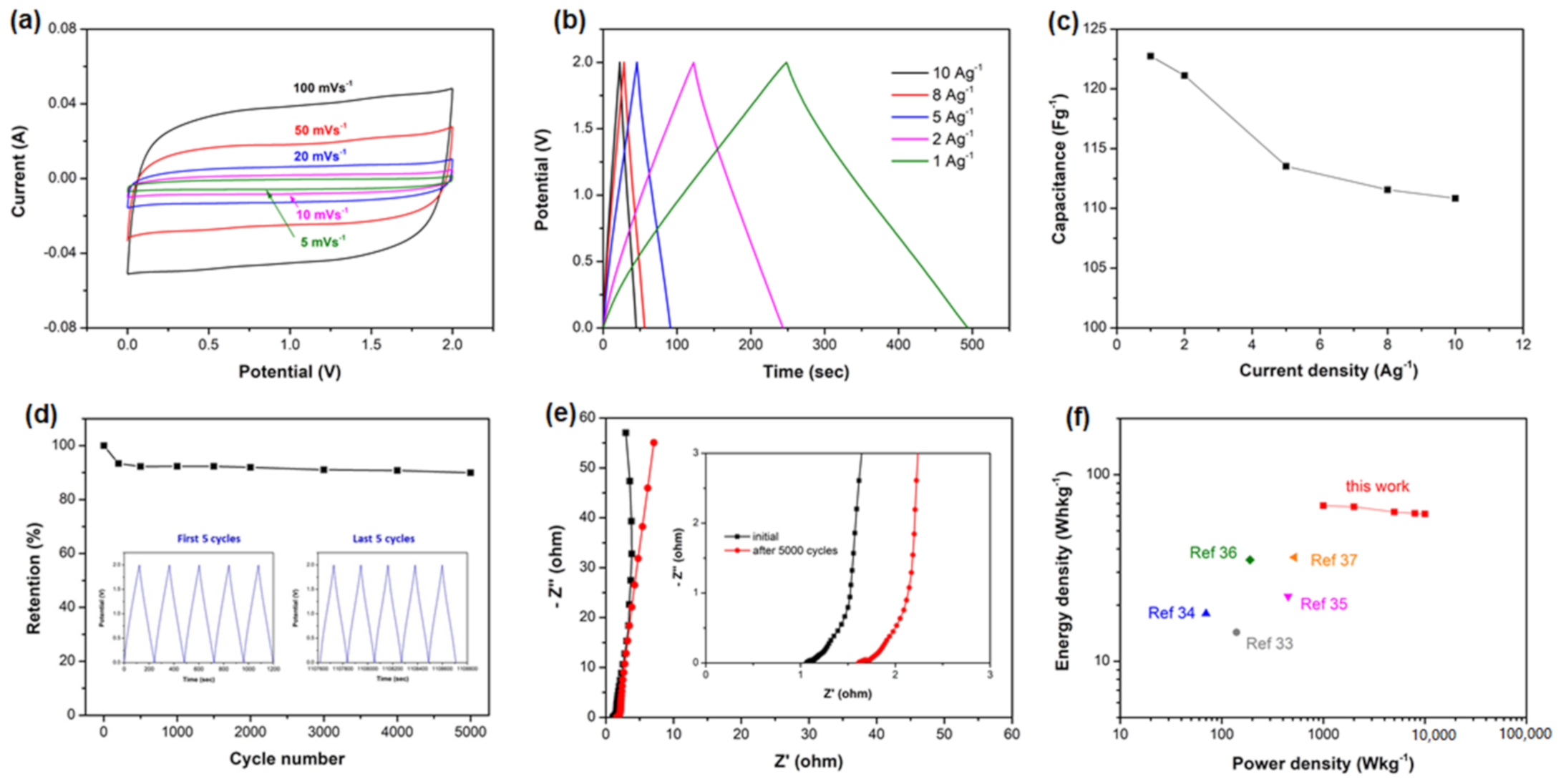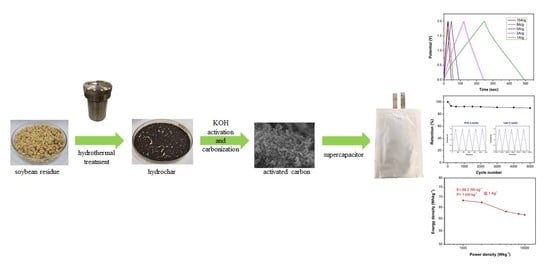Biomass-Derived Porous Carbons Derived from Soybean Residues for High Performance Solid State Supercapacitors
Abstract
1. Introduction
2. Results
2.1. Texture and Morphology Analysis
2.2. Structure Analysis
2.3. Composition Analysis
2.4. Electrochemical Performance of the Electrode
2.5. Electrochemical Performance of the Symmetric Supercapacitor
3. Materials and Methods
3.1. Chemicals and Materials
3.2. Fabrication of SRAC
3.3. Materials Characterization
3.4. Preparation of Electrodes and Assembly of Symmetric Supercapacitor
3.5. Electrochemical Measurements
4. Conclusions
Author Contributions
Funding
Acknowledgments
Conflicts of Interest
References
- Mensah-Darkwa, K.; Zequine, C.; Kahol, P.K.; Gupta, R.K. Supercapacitor energy storage device using biowastes: A sustainable approach to green energy. Sustainability 2019, 11, 414. [Google Scholar] [CrossRef]
- Li, Z.; Guo, D.; Liu, Y.; Wang, H.; Wang, L. Recent advances and challenges in biomass-derived porous carbon nanomaterials for supercapacitors. Chem. Eng. J. 2020, 397, 125418. [Google Scholar] [CrossRef]
- Jiang, X.; Shi, G.; Wang, G.; Mishra, P.; Liu, C.; Dong, Y.; Zhang, P.; Tian, H.; Liu, Y.; Wang, Z.; et al. Hydrothermal carbonization process for the preparation of activated carbons from hemp straw: An efficient electrode material for supercapacitor application. Ionics 2019, 25, 3299–3307. [Google Scholar] [CrossRef]
- Jin, H.; Li, J.; Yuan, Y.; Wang, J.; Lu, J.; Wang, S. Recent progress in biomass-derived electrode materials for high volumetric performance supercapacitors. Adv. Energy Mater. 2018, 8, 1801007. [Google Scholar] [CrossRef]
- Abioye, A.M.; Ani, F.N. Recent development in the production of activated carbon electrodes from agricultural waste biomass for supercapacitors: A review. Renew. Sustain. Energy Rev. 2015, 52, 1282–1293. [Google Scholar] [CrossRef]
- Jiang, Q.; Liu, D.; Liu, B.; Zhou, T.; Zhou, J. Blotting paper-derived activated porous carbon/reduced graphene oxide composite electrodes for supercapacitor applications. Molecules 2019, 24, 4625. [Google Scholar] [CrossRef]
- Peng, L.; Fang, Z.; Zhu, Y.; Yan, C.; Yu, G. Holey 2D nanomaterials for electrochemical energy storage. Adv. Energy Mater. 2018, 8, 1702179. [Google Scholar] [CrossRef]
- Jiang, J.; Zhang, Y.; Nie, P.; Xu, G.; Shi, M.; Wang, J.; Wu, Y.; Fu, R.; Dou, H.; Zhang, X. Progress of nanostructured electrode materials for supercapacitors. Adv. Sustain. Syst. 2018, 2, 1700110. [Google Scholar] [CrossRef]
- Huang, Y.; Zeng, Y.; Yu, M.; Liu, P.; Tong, Y.; Cheng, F.; Lu, X. Recent smart methods for achieving high-energy asymmetric supercapacitors. Small Methods 2018, 2, 1700230. [Google Scholar] [CrossRef]
- Zou, Z.; Lei, Y.; Li, Y.; Zhang, Y.; Xiao, W. Nitrogen-doped hierarchical meso/microporous carbon from bamboo fungus for symmetric supercapacitor applications. Molecules 2019, 24, 3677. [Google Scholar] [CrossRef]
- Jain, A.; Balasubramanian, R.; Srinivasan, M. P Hydrothermal conversion of biomass waste to activated carbon with high porosity: A review. Chem. Eng. J. 2016, 283, 789–805. [Google Scholar] [CrossRef]
- Hu, B.; Wang, K.; Wu, L.; Yu, S.H.; Antonietti, M.; Titirici, M. Engineering carbon materials from the hydrothermal carbonization process of biomass. Adv. Mater. 2010, 22, 813–828. [Google Scholar] [CrossRef] [PubMed]
- Hao, P.; Zhao, Z.; Li, L.; Tuan, C.-C.; Li, H.; Sang, Y.; Jiang, H.; Wong, C.; Liu, H. The hybrid nanostructure of MnCo 2 O 4.5 nanoneedle/carbon aerogel for symmetric supercapacitors with high energy density. Nanoscale 2015, 7, 14401–14412. [Google Scholar] [CrossRef] [PubMed]
- Jain, A.; Xu, C.; Jayaraman, S.; Balasubramanian, R.; Lee, J.; Srinivasan, M.P. Mesoporous activated carbons with enhanced porosity by optimal hydrothermal pre-treatment of biomass for supercapacitor applications. Microporous Mesoporous Mater. 2015, 218, 55–61. [Google Scholar] [CrossRef]
- Miao, Q.; Tang, Y.; Xu, J.; Liu, X.; Xiao, L.; Chen, Q. Activated carbon prepared from soybean straw for phenol adsorption. J. Taiwan Inst. Chem. Eng. 2013, 44, 458–465. [Google Scholar] [CrossRef]
- Lei, Z.; Christov, N.; Zhang, L.L.; Zhao, X.S. Mesoporous carbon nanospheres with an excellent electrocapacitive performance. J. Mater. Chem. 2011, 21, 2274–2281. [Google Scholar] [CrossRef]
- Rose, M.; Korenblit, Y.; Kockrick, E.; Borchardt, L.; Oschatz, M.; Kaskel, S.; Yushin, G. Hierarchical micro-and mesoporous carbide-derived carbon as a high-performance electrode material in supercapacitors. Small 2011, 7, 1108–1117. [Google Scholar] [CrossRef]
- Li, Q.; Jiang, R.; Dou, Y.; Wu, Z.; Huang, T.; Feng, D.; Yang, J.; Yu, A.; Zhao, D. Synthesis of mesoporous carbon spheres with a hierarchical pore structure for the electrochemical double-layer capacitor. Carbon 2011, 49, 1248–1257. [Google Scholar] [CrossRef]
- Peng, Z.; Guo, Z.; Chu, W.; Wei, M. Facile synthesis of high-surface-area activated carbon from coal for supercapacitors and high CO2 sorption. RSC Adv. 2016, 6, 42019–42028. [Google Scholar] [CrossRef]
- Fan, W.; Xia, Y.-Y.; Tjiu, W.W.; Pallathadka, P.K.; He, C.; Liu, T. Nitrogen-doped graphene hollow nanospheres as novel electrode materials for supercapacitor applications. J. Power Sources 2013, 243, 973–981. [Google Scholar] [CrossRef]
- Deng, W.; Zhang, Y.; Yang, L.; Tan, Y.; Ma, M.; Xie, Q. Sulfur-doped porous carbon nanosheets as an advanced electrode material for supercapacitors. RSC Adv. 2015, 5, 13046–13051. [Google Scholar] [CrossRef]
- Chen, J.; Fang, K.; Chen, Q.; Xu, J.; Wong, C.-P. Integrated paper electrodes derived from cotton stalks for high-performance flexible supercapacitors. Nano Energy 2018, 53, 337–344. [Google Scholar] [CrossRef]
- Jansen, R.; van Bekkum, H. XPS of nitrogen-containing functional groups on activated carbon. Carbon 1995, 33, 1021–1027. [Google Scholar] [CrossRef]
- Rufford, T.E.; Hulicova-Jurcakova, D.; Zhu, Z.; Lu, G.Q. Nanoporous carbon electrode from waste coffee beans for high performance supercapacitors. Electrochem. Commun. 2008, 10, 1594–1597. [Google Scholar] [CrossRef]
- Chen, L.-C.; Peng, P.-Y.; Lin, L.-F.; Yang, T.C.; Huang, C.-M. Facile preparation of nitrogen-doped activated carbon for carbon dioxide adsorption. Aerosol Air Qual. Res. 2013, 14, 916–927. [Google Scholar] [CrossRef]
- Zhu, H.; Wang, X.; Yang, F.; Yang, X. Promising carbons for supercapacitors derived from fungi. Adv. Mater. 2011, 23, 2745–2748. [Google Scholar] [CrossRef]
- Sevilla, M.; Mokaya, R.; Science, E. Energy storage applications of activated carbons: Supercapacitors and hydrogen storage. Energy Environ. Sci. 2014, 7, 1250–1280. [Google Scholar] [CrossRef]
- Wang, J.; Zhang, X.; Li, Z.; Ma, Y.; Ma, L. Recent progress of biomass-derived carbon materials for supercapacitors. J. Power Sources 2020, 451, 227794. [Google Scholar] [CrossRef]
- Qie, L.; Chen, W.; Xu, H.; Xiong, X.; Jiang, Y.; Zou, F.; Hu, X.; Xin, Y.; Zhang, Z.; Huang, Y. Synthesis of functionalized 3D hierarchical porous carbon for high-performance supercapacitors. Energy Environ. Sci. 2013, 6, 2497–2504. [Google Scholar] [CrossRef]
- Fan, X.; Yu, C.; Yang, J.; Ling, Z.; Qiu, J. Hydrothermal synthesis and activation of graphene-incorporated nitrogen-rich carbon composite for high-performance supercapacitors. Carbon 2014, 70, 130–141. [Google Scholar] [CrossRef]
- Lu, H.; Zhuang, L.; Gaddam, R.R.; Sun, X.; Xiao, C.; Duignan, T.; Zhu, Z.; Zhao, X.S. Microcrystalline cellulose-derived porous carbons with defective sites for electrochemical applications. J. Mater. Chem. A 2019, 7, 22579–22587. [Google Scholar] [CrossRef]
- Israelachvili, J.N. Intermolecular and Surface Forces: Revised Third Edition; Academic Press: Cambridge, MA, USA, 2011; Available online: https://doi.org/10.1016/C2011-0-05119-0 (accessed on 26 August 2020).
- Long, C.; Jiang, L.; Wu, X.; Jiang, Y.; Yang, D.; Wang, C.; Wei, T.; Fan, Z. Facile synthesis of functionalized porous carbon with three-dimensional interconnected pore structure for high volumetric performance supercapacitors. Carbon 2015, 93, 412–420. [Google Scholar] [CrossRef]
- Ferrero, G.; Fuertes, A.; Sevilla, M. From Soybean residue to advanced supercapacitors. Sci. Rep. 2015, 5, 16618. [Google Scholar] [CrossRef] [PubMed]
- Liu, Z.; Zhu, Z.; Dai, J.; Yan, Y. Waste biomass based-activated carbons derived from soybean pods as electrode materials for high-performance supercapacitors. Chem. Sel. 2018, 3, 5726–5732. [Google Scholar] [CrossRef]
- Wang, S.; Sun, W.; Yang, D.-S.; Yang, F. Conversion of soybean waste to sub-micron porous-hollow carbon spheres for supercapacitor via a reagent and template-free route. Mater. Today Energy 2019, 13, 50–55. [Google Scholar] [CrossRef]
- Xu, R.-X.; Zhao, Y.-P.; Liu, G.-H.; Zhu, J.-S.; Wang, R.-Y.; Cao, J.-P.; Wei, X.-Y. N/O co-doped porous interconnected carbon nanosheets from the co-hydrothermal treatment of soybean stalk and nickel nitrate for high-performance supercapacitors. J. Colloid Interface Sci. 2020, 558, 211–219. [Google Scholar] [CrossRef]
- Pan, G.-T.; Chong, S.; Yang, T.C.-K.; Huang, C.-M. Electrodeposited porous Mn1. 5Co1. 5O4/Ni composite electrodes for high-voltage asymmetric supercapacitors. Materials 2017, 10, 370. [Google Scholar] [CrossRef]
- Erusappan, E.; Pan, G.-T.; Chung, H.-Y.; Chong, S.; Thiripuranthagan, S.; Yang, T.C.-K.; Huang, C.-M. Hierarchical nickel–cobalt oxide and glucose-based carbon electrodes for asymmetric supercapacitor with high energy density. J. Taiwan Inst. Chem. Eng. 2020, 112, 330–336. [Google Scholar] [CrossRef]
- Tsai, Y.-C.; Yang, W.-D.; Lee, K.-C.; Huang, C.-M. An effective electrodeposition mode for porous MnO2/Ni foam composite for asymmetric supercapacitors. Materials 2016, 9, 246. [Google Scholar] [CrossRef]
Sample Availability: Samples of the compounds are available from the authors. |






| Sample | Textural Properties | XPS (atom %) | ||||||
|---|---|---|---|---|---|---|---|---|
| SBET (m2 g−1) | Smic (m2 g−1) | Vt (cm3 g−1) | Vmic (cm3 g−1) | Dave (nm) | C | N | O | |
| SRAC10 | 1351 | 817 | 0.86 | 0.37 | 2.55 | 85.0 | 1.3 | 13.7 |
| SRAC7 | 1476 | 809 | 0.94 | 0.36 | 2.35 | 85.3 | 1.6 | 13.1 |
| SRAC5 | 1945 | 1034 | 1.13 | 0.47 | 2.34 | 80.4 | 3.8 | 15.8 |
| Sample | Nitrogen Functional Groups (%) | |||
|---|---|---|---|---|
| Pyridinic-N (398.5 ± 0.2 eV) | Pyrrolic-/Pyridonic-N (400.5 ± 0.3 eV) | Quaternary-N (401.2 ± 0.2 eV) | Pyridine-N-Oxide (402.9 ± 0.4 eV) | |
| SRAC10 | 10.3 | 51.7 | 3.5 | 34.5 |
| SRAC7 | 34.1 | 63.9 | - | 2.00 |
| SRAC5 | 35.3 | 44.3 | 12.7 | 7.7 |
| Preparation Process | Electrolyte | Potential Window | Energy Density | Cycling Stability | Reference |
|---|---|---|---|---|---|
| Thermal-treatment of KOH-soaked soybean | 1 M Na2SO4 aqueous solution | 1.8 V | 14.3 Wh kg−1 | - | [33] |
| Hydrothermal treatment, KOH activation and then carbonization | 1 M Li2SO4 aqueous solution | 1.7 V | 18 Wh kg−1 (at 0.2 Ag−1) | 10,000 cycles: 90–95% retention | [34] |
| Hydrothermal treatment, KOH activation and then carbonization | 1 M Na2SO4 aqueous solution | 2.0 V | 22.28 Wh kg−1 (at 0.5 Ag−1) | 10,000 cycles: 91.1% retention at 5 Ag−1 | [35] |
| Hydrothermal and then carbonization | 1 M Na2SO4 aqueous solution | 1.9 V | 35 Wh kg−1 (at 0.1 Ag−1) | 2000 cycles: 81.4% retention at 0.5 Ag−1 | [36] |
| Hydrothermal treatment, carbonization and then KOH activation | 6 M KOH aqueous solution | 1.0 V | 36.11 Wh kg−1 (at 0.5 Ag−1) | 10,000 cycles: 87.5% retention at 10 Ag−1 | [37] |
| Hydrothermal treatment, KOH activation and then carbonization | CMC–LiNO3 gel electrolyte | 2.0 V | 68.19 Wh kg−1 (at 1.0 Ag−1) | 5000 cycles: 89.9% retention at 2 Ag−1 | This work |
© 2020 by the authors. Licensee MDPI, Basel, Switzerland. This article is an open access article distributed under the terms and conditions of the Creative Commons Attribution (CC BY) license (http://creativecommons.org/licenses/by/4.0/).
Share and Cite
Chung, H.-Y.; Pan, G.-T.; Hong, Z.-Y.; Hsu, C.-T.; Chong, S.; Yang, T.C.-K.; Huang, C.-M. Biomass-Derived Porous Carbons Derived from Soybean Residues for High Performance Solid State Supercapacitors. Molecules 2020, 25, 4050. https://doi.org/10.3390/molecules25184050
Chung H-Y, Pan G-T, Hong Z-Y, Hsu C-T, Chong S, Yang TC-K, Huang C-M. Biomass-Derived Porous Carbons Derived from Soybean Residues for High Performance Solid State Supercapacitors. Molecules. 2020; 25(18):4050. https://doi.org/10.3390/molecules25184050
Chicago/Turabian StyleChung, Hsiu-Ying, Guan-Ting Pan, Zhong-Yun Hong, Chun-Tsung Hsu, Siewhui Chong, Thomas Chung-Kuang Yang, and Chao-Ming Huang. 2020. "Biomass-Derived Porous Carbons Derived from Soybean Residues for High Performance Solid State Supercapacitors" Molecules 25, no. 18: 4050. https://doi.org/10.3390/molecules25184050
APA StyleChung, H.-Y., Pan, G.-T., Hong, Z.-Y., Hsu, C.-T., Chong, S., Yang, T. C.-K., & Huang, C.-M. (2020). Biomass-Derived Porous Carbons Derived from Soybean Residues for High Performance Solid State Supercapacitors. Molecules, 25(18), 4050. https://doi.org/10.3390/molecules25184050











